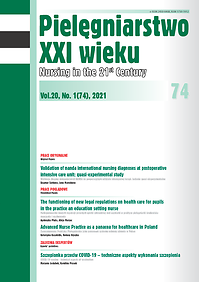COVID-19 vaccine – technical aspects of vaccination
DOI:
https://doi.org/10.2478/pielxxiw-2021-0009Keywords:
coronavirus, vaccine, nurseAbstract
COVID-19 VACCINE - TECHNICAL ASPECTS OF VACCINATION
Introduction. All over the world the fight against the SARS-CoV-2 virus, which causes COVID-19, has already begun. Very quick development and testing of medicinal preparations with such a high efficiency (94-95%), which can be administered to adult patients for mass immunization, makes this fight possible. The production and delivery of a huge number of vaccines remains a challenge, but an undoubtedly important aspect is the safe and compliant administration of medicinal preparations. People currently authorized to administer COVID-19 vaccines are doctors, paramedics, nurses, midwives, and school hygienists. However, there is a lot of conflicting information on how to administer the COVID-19 vaccine.
Conclusion. Nurses have administered vaccination since many years, having proper education and experience. Nowadays available vaccines against COVID-19 are administered intramuscularly into the deltoid muscle. The recommendations say that administering of the vaccine must be performed with 90 degrees to the surface of the skin simultaneously stretching the skin with index finger and thumb, without aspiration after injection. This article presents basic information about the vaccine and the algorithm for administering the COVID-19 vaccine developed by the authors.
References
1. Narodowy Program Szczepień https://www.gov.pl/web/szczepimysie/narodowy-program-szczepien-przeciw-covid-19 (dostęp 06.01.2021)
2. Rozporządzenie Ministra Zdrowia z dnia 27 lutego 2020 r. w sprawie zakażenia koronawirusem SARS-CoV-2.
3. Charakterystyka produktu leczniczego Comirnaty https://www.fda.gov/ media/144413/download?utm_medium=email&utm_source=govdelivery (dostęp 06.01.2021).
4. Charakterystyka produktu leczniczego Moderna https://www.fda.gov/ media/144637/download (dostęp 10.01.2021).
5. Kwestionariusz wstępnego wywiadu przesiewowego przed szczepieniem osoby dorosłej przeciw COVID-19 https://szczepienia.pzh.gov.pl/wp-content/ uploads/2020/12/kwestionariusz_szczepienia_z_oswiadczeniem.pdf (dostęp 06.01.2021).
6. Czajka H. Podstawowe zasady wykonywania szczepień ochronnych https:// www.mp.pl/szczepienia/praktyka/porocedury/71176,podstawowe-zasady-wykonywania-szczepien-ochronnych (dostęp 06.01.2021).
7. Matkowska-Kocjan A. Co zrobić, jeśli w trakcie wykonywania szczepienia w igle pojawi się krew? https://www.mp.pl/szczepienia/ekspert/technika_organizacja_ szczepien/151264,unikanie-aspiracji-przy-podawaniu-szczepionek?fbclid=IwAR 2JxHHOs3j6Q392NZlXFprwLa-9TxyEnDCO_7aDQwbq95cV17BYw1Imudg (dostęp 15.01.2021).
8. Kroger AT, Sumaya CV, Pickering LK, et al. General recommendations on immunization. Recommendations of the Advisory Committee on Immunization Practices (ACIP). Morbidity and Mortality Weekly Report, 2011; 60 (RR-02): 1–60
9. Sepah Y, Samad L, Altaf A, et al. Aspiration in injections: should we continue or abandon the practice? F1000 Research, 2017; 3.
10. Taddio A, McMurtry CM, Shah V, et al. Reducing pain during vaccine injections: clinical practice guideline. CMAJ, 2015; 187: 975–982.
11. Ogólne wytyczne dotyczące szczepień ochronnych. Zalecenia Amerykańskiego Komitetu Doradczego ds. Szczepień Ochronnych (ACIP). Med. Prakt. Pediatr., WS 1/2009 (na podstawie: General Recommendations on Immunization: Recommendations of the Advisory Committee on Immunization Practices. MMWR 2006; 55 (RR 15): 1–48.
12. Rządowa strona dotycząca szczepień i całego procesu https://www.gov.pl/web/ szczepimysie (dostęp 15.01.2021).
Downloads
Published
Issue
Section
License
Copyright (c) 2021 Authors

This work is licensed under a Creative Commons Attribution-NonCommercial-NoDerivatives 4.0 International License.




